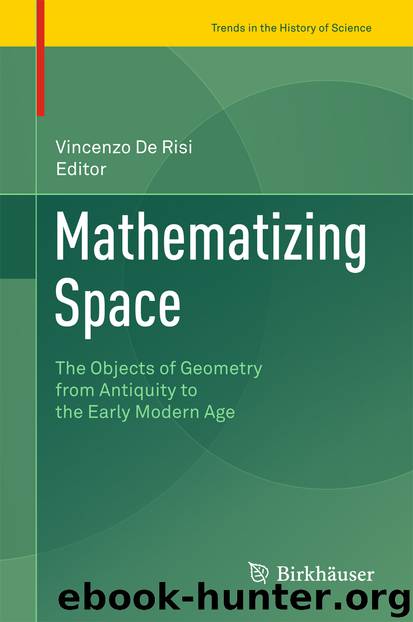Mathematizing Space by Vincenzo Risi

Author:Vincenzo Risi
Language: eng
Format: epub
Publisher: Springer International Publishing, Cham
Fig. 4Visual angle, size, and distance illustrated in the visual pyramid. Part (a) illustrates the relation between a common visual angle and objects A and B at different distances. Since A occludes B, one should think of the objects as seen one at a time. Part (b) shows the relation between visual angle and objects A and B of different sizes but at the same distance
The extramission theorist Ptolemy held that the outstretching visual rays allow us to see the objects where they are, because the rays touch them. Ptolemy held that only light and surface color are intrinsically and primarily perceptible. We see bodies with colors through visual rays, and we discern distance directly through the length of those rays (Ptolemy ca. 160 [1996, pp. 71–72, 81–82]). The perception of the spatial locations and spatial properties of objects is a tidy affair: the rays touch the surfaces of objects in a geometrically precise and orderly manner. In perceiving size, we take distance (the length of the rays) into account (1996, pp. 93–94). Thus, in Fig. 4a, object A would be perceived as being closer and smaller than object B. If no illusion is involved (such as occurs when the distance to the moon is misperceived),3 each object would be perceived at its true distance with its true size. The location and distance of the visual rays would determine the perception of direction, distance, and size.
In the history of visual theory, extramission theories were supplanted by intromission theories, according to which the eye is affected by light that has been reflected from the surfaces of objects. For intromission theorists, distance is no longer “given” by the length of extramitted rays, but must somehow be discerned from the response of the eye and optical system to the incoming light. Moreover, since from every point on a normal, matte object (not a mirror) light is scattered, light from each point bathes the entire front of the eye (see Fig. 1). This dispersal of the light creates a second problem not faced by the extramission theory: how to establish a one-to-one correspondence between a surface or other structure in the eye and the array of visible points lying ordered in the field of vision. Such a correspondence is required in explaining the basic fact that we perceive an orderly visual world. In its absence, the eye could sense only a blur, more profound than that experienced without one’s glasses.
Ibn al-Haytham , an Islamic natural philosopher who flourished about 1020, proposed a solution to this problem. He ascribed to the eye a selective sensitivity to the rays perpendicular to the cornea and crystalline humor (Fig. 5). The other rays scattered from the object are not received. Hence, an orderly one-to-one relationship is established. Still, the problem of how we perceive distance remains. Here Ibn al-Haytham distinguished what is directly sensed by vision from what is achieved by the visual faculty with the aid of “discernment, inference, recognition,” and “prior knowledge” (ca. 1030 [1989], II.3.71). He held that the sense of sight perceives light and color by “pure sensation” (II.
Download
This site does not store any files on its server. We only index and link to content provided by other sites. Please contact the content providers to delete copyright contents if any and email us, we'll remove relevant links or contents immediately.
Enlightenment Now: The Case for Reason, Science, Humanism, and Progress by Steven Pinker(7270)
A Journey Through Charms and Defence Against the Dark Arts (Harry Potter: A Journey Through…) by Pottermore Publishing(4789)
The Immortal Life of Henrietta Lacks by Rebecca Skloot(4547)
A Journey Through Divination and Astronomy by Publishing Pottermore(4363)
Elon Musk by Ashlee Vance(4082)
Origin Story: A Big History of Everything by David Christian(3665)
COSMOS by Carl Sagan(3584)
Alchemy and Alchemists by C. J. S. Thompson(3480)
Bad Pharma by Ben Goldacre(3395)
Enlightenment Now by Steven Pinker(3348)
Shadow of Night by Deborah Harkness(3324)
Inferior by Angela Saini(3293)
A Mind For Numbers: How to Excel at Math and Science (Even If You Flunked Algebra) by Barbara Oakley(3248)
Origin Story by David Christian(3169)
The Code Book by Simon Singh(3123)
Signature in the Cell: DNA and the Evidence for Intelligent Design by Stephen C. Meyer(3097)
The Elements by Theodore Gray(3024)
A Brief History of Time by Stephen Hawking(2990)
A Journey Through Potions and Herbology (A Journey Through…) by Pottermore Publishing(2836)
